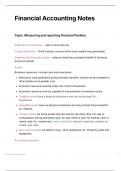Summary
Summary Accounting and Finance for Non-specialists - FINANCIAL ACCOUNTING
- Module
- FINANCIAL ACCOUNTING
- Institution
- Aston University, Birmingham (Aston)
Financial accounting notes for 1. Measuring and Reporting Financial Position 2. Measuring and Reporting financial Performance 3. Accounting for limited companies 4. Measuring and Reporting Cash Flows
[Show more]



